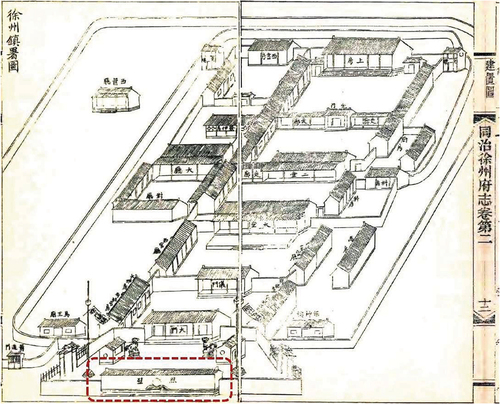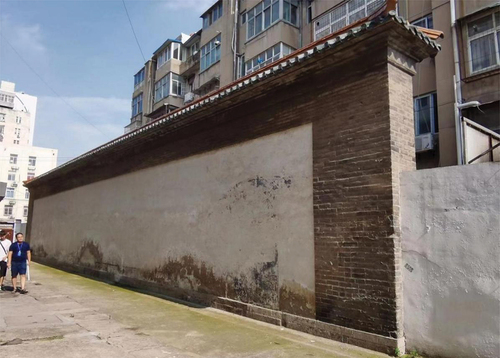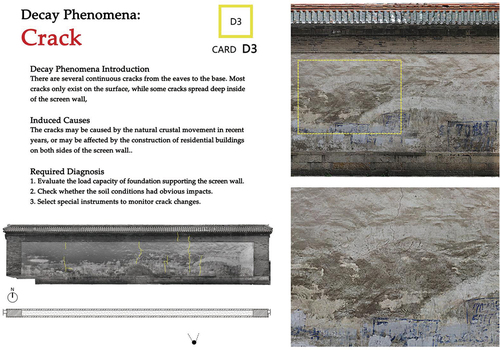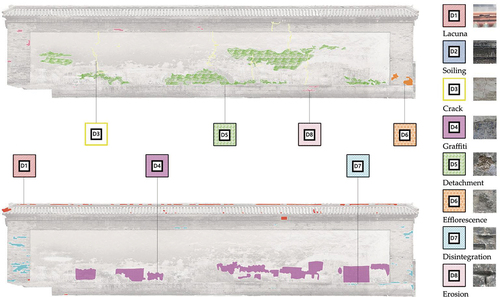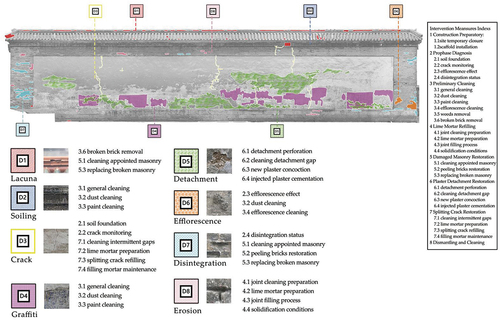ABSTRACT
Materials are important carriers of historical information of masonry architectural heritage and can also directly reflect decay problems due to environmental factors during building use, which are key factors to be considered in architectural heritage conservation. Therefore, the aim of this study was to identify the logicality and effectiveness of conservation mechanism based on material deterioration analysis. In this study, the Xuhai Dao Shu screen wall at the Xuzhou cultural relic building was selected as a pilot site. The research method involved the innovative use of orthophoto images derived in three-dimensional software for analyzing the materials and decay phenomena of the screen wall. The results indicated that there were five types of architectural materials and eight types of decay phenomena associated with the Xuhai Dao Shu screen wall, and through examination, corresponding conservation measures were proposed based on the specific deterioration causes with illustrations of possible intervention measures. This study demonstrated that the conservation mechanism identified based on material deterioration mechanism analysis, can aid in obtaining the existing material and decay information and formulating more pertinent conservation paradigm for preserving the authenticity of masonry architectural heritage.
Graphical abstract
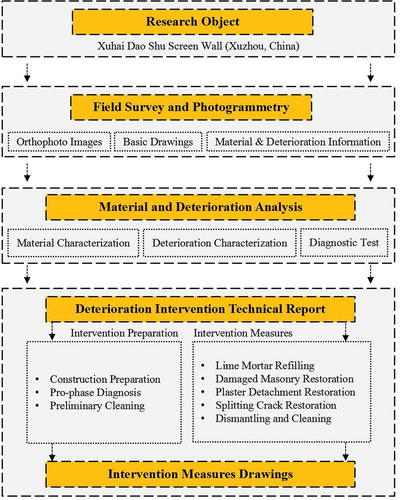
1. Introduction
Masonry buildings are an important architectural heritage type in China, and increasing attention has been given to their conservation in recent years (Wang Citation2022; Chang Citation2018). Although various restoration projects have enhanced the preservation status of masonry architectural heritage, many problems regarding the associated principles and interventions have also been exposed (Zhu Citation2020). For example, certain intervention measures ignore the authenticity requirements of heritage conservation and arbitrarily replace existing materials, thereby destroying the original architectural style (Li and Wang Citation2020; Li Citation2019). The main problem lies in the lack of in-depth analysis of existing materials and decay phenomena (Della Torre Citation2021; Dai and Zhong Citation2017), which makes it difficult to facilitate accurate conservation strategies and techniques with comprehensive and multidisciplinary knowledge (Cantagallo et al. Citation2020). Therefore, research on conservation mechanism evaluation based on material deterioration analysis of masonry architectural heritage sites is particularly significant.
Initially, deterioration classification of masonry architectural heritage is the basis of subsequent analysis and conservation. Present deterioration classification mainly includes various relevant standards (China National Cultural Heritage Administration Citation2008; ICOMOS-ISCS Citation2008), all of which provide an important foundation for deterioration classification. Moreover, many scholars have also researched specific deterioration cases at masonry architectural heritage sites. Shekofteh et al. (Citation2019) selected architectural relics at the Pasargadae world heritage site and summarized the specific decay patterns of three stone materials. Liu (Citation2019) conducted a large number of field investigations and studies to categorize decay phenomena of masonry cultural relics, including stains, cracks, and efflorescence. Randazzo et al. (Citation2020) obtained information and data from a field survey conducted by the San Domenico Church in south Calabria to provide comprehensive records of decay phenomena. Angjeliu, Coronelli, and Cardani (Citation2020) studied historical masonry buildings by developing a simulation model based on digital twins. Sangirardi et al. (Citation2022) expressed the characterization of decay phenomena through visual means. These studies have provided important methods regarding deterioration analysis and characterization of masonry architectural heritage.
From another aspect, Liu and Chen (Citation2017) mainly examined the influence of meteorological parameters on the efflorescence phenomenon of brick cultural relic buildings. Muhealddin, Ali, and Abdulrahman (Citation2020) classified the decay-inducting factors at architectural heritage sites into four categories: internal natural factors, external natural factors, deliberate human damage and accordant human damage. Wang (Citation2020) mainly focused on decay phenomena of masonry architectural heritage caused by moisture factors in the Wudang Mountain area. Flora et al. (Citation2022) chiefly considered the damage caused by seismic action to masonry structures and the seismic behavior under dynamic interaction. Sass and Viles (Citation2022) found an actual correlation between the decay process of masonry buildings and the water change including the short-term and long-term trends. The research indicated the main inductive factors in specific cases of masonry architectural heritage, and possible solutions emerged from this study to develop appropriate verification methods for the causes of deterioration.
Consequently, the formulation of effective overall conservation strategies is crucial after clarifying the deterioration and inductive factors. Feng (Citation2011) proposed comprehensive conservation strategies based on the deterioration mechanism of masonry cultural relics in a moist environment. Dai and Zhang (Citation2014) introduced technical guidelines to mitigate the decay problems of stone and brick materials at architectural heritage sites. Musso and Franco (Citation2015) improved the preservation status of Italian stone vernacular dwellings by formulating guidelines for the mitigation of present decay phenomena. Chun (Citation2015) systematically demonstrated the conservation strategies of masonry architectural heritage through different typical cases in a separate part of their research. Borri and Corradi (Citation2019) evaluated the impacts of existing interventions on masonry structures and discussed the possible conservation guidelines, which highlighted some limitations and important advancements. These researches have revealed the conservation of masonry architectural heritage from an overall perspective and have provided an overall logical framework for the conservation strategies proposed in this study.
In contrast, Giambruno and Pistidda (Citation2018) established specific intervention measures for masonry architectural heritage through the case of the Haram gate in Pakistan. Zhu and Chun (Citation2019) proposed comprehensive strengthening techniques based on the actual decay conditions of the Yongchang stone bridge. Yildizlar, Sayin, and Akcay (Citation2020) selected a case of masonry architectural heritage built in the early 1940s and determined materials via chemical and mineralogical analyses. Orr et al. (Citation2020) studied the different advantages and characteristics of microwaves and radar in moisture measurements of stone masonry with different materials. Pinho, Lamas, and Teotónio (Citation2022) carried out consolidation treatments to reinforce the mechanical properties of stone masonry. These studies have verified that conservation techniques through specific decay phenomena are the most scientific research approach.
In summary, the present research indicates that the conservation and maintenance of masonry architectural heritage not only follow existing principles and standards but also rely on effective detection and analysis methods to fully summarize the decay phenomena of existing materials and deeply explore deterioration causes, which is the foundation for proposing scientific and effective conservation strategies and intervention measures. Nevertheless, through a literature review, the research on the comprehensive assessment of logical relations among the characterization, analysis and intervention of deterioration problems remains insufficient, and the conservation mechanism based on material deterioration analysis of masonry architectural heritage has not been examined by the effects in the actual conservation project.
Therefore, in this study, the conservation case of the Xuhai Dao Shu screen wall (Xuzhou, China) was selected as a pilot. Then, with the literature summary, digital photogrammetry was conducted to intuitively reflect and analyze the existing materials and deterioration problems of the screen wall. By combining relevant diagnostic test methods, optimal conservation strategies and intervention measures could be formulated according to the obtained data to improve the conservation status of the Xuhai Dao Shu screen wall. Ultimately, the essential process and critical elements for the conservation mechanism based on material deterioration analysis were verified, and the actual conservation effect of masonry architectural heritage was fully demonstrated.
2. Description of the pilot site
Xuhai Dao Shu was the highest administrative unit with jurisdiction over Xuzhou city and its surrounding 12 counties during the Ming and Qing Dynasties (Sun Citation2000). Xuhai Dao Shu was built in 1378 with a total of 35 buildings, but due to the destruction caused by war, only the lobby of the second compound and screen wall remained. The Xuhai Dao Shu screen wall is now located in Wenting Street of Xuzhou city, and the wall is approximately 30 meters long and 5.6 meters high, which is the largest existing screen wall in Xuzhou city (Li Citation2014). The center of the screen wall was once painted with Dahai Risheng Tu (referring to sunrise over the sea), which no longer exists and can now only be identified in the Xuhai Dao Shu chorography in Xuzhou local chronicles (). In June 2006, the Xuhai Dao Shu screen wall was listed as a Jiangsu Provincial Cultural Relics Protection Unit, which also fully reflects its historical and cultural value.
The architectural materials of the Xuhai Dao Shu screen wall mainly include brick, stone, mortar and plaster, and the site is a typical Chinese masonry architectural heritage site. In the 1990s, the Xuzhou Municipal Bureau of Cultural Relics conducted a restoration project of the Xuhai Dao Shu screen wall, but many problems were exposed during the actual intervention. For instance, the original roof was changed from green glazed tiles to yellow glazed tiles, and the size was much smaller than that of the original glazed tiles, which had changed the authentic appearance of the screen wall to some extent. Moreover, because of the long-term environmental effects and lack of effective daily maintenance, the architectural materials of the screen wall suffered many decay problems, such as lacuna, soiling, crack, graffiti, etc. (). After comprehensive consideration of the architectural scale, material categories, decay phenomena and other factors, the Xuhai Dao Shu screen wall was selected as the pilot site in this study. Furthermore, through the exhaustive investigation and analyses of the actual decay phenomena, the logicality and effectiveness of the conservation mechanism based on material deterioration analysis were fully better explored and verified.
3. Materials and methods
3.1. Field survey and photogrammetry
Field surveys and photogrammetry are the basis of material deterioration analysis. To ensure the quality of the high-resolution photos, field surveys should be preferentially conducted during the day with sufficient light. As the overall height of the Xuhai Dao Shu screen wall is approximately 5.6 meters, the segmented photogrammetry strategy was adopted, and the screen wall was divided into four sections according to the different heights. From 0 to 1.8 meters, a tripod was erected on the ground for fixed photographing. The other three sections with heights ranging from 1.8 to 3.3 meters, 3.3 to 4.8 meters, and 4.8 to 5.6 meters were photographed with the use of ladders. During the photography process, the focal length and other parameters of the camera remained fixed. Moreover, according to a tape ruler placed in front, the photography position was moved by 50 cm after each shot so that the overlapping degree of the obtained continuous photos exceeded 70%, which effectively ensured construction of the visualization model. Because the site of the screen wall was surrounded by residential buildings with wires arranged in a disorderly manner, it was impossible to use an unmanned drone for aerial photography to capture the top of the Xuhai Dao Shu screen wall, and photography was only conducted in the residential corridors on both sides of the screen wall.
Since the surface texture of the visualization model was based on the highly detailed images obtained at the site, certain important matters were considered in the photography process to meet the needs of material deterioration analysis. For example, to ensure that the model size remained consistent with the actual size of the screen wall, a photo scale was placed for reference when obtaining the first three photos. When encountering obstacles such as clothes drying poles, multiple angles were selected for supplementary photography to ensure a more realistic and accurate visualization model. Furthermore, the sequence of photos was archived and sorted to facilitate analysis and calculation in three-dimensional modeling software. Eventually, a total of 735 highly detailed images (5760 × 3840 pixels per photo) were collected to develop a visual model of screen wall.
3.2. Orthophoto images and basic drawings acquisition
After the field survey and photogrammetry implementation, Agisoft Photoscan software was selected to build a screen wall model by comprehensively considering the operation and economic factors (Santoso et al. Citation2016; Zhao, Tong, and Yan Citation2021). The obtained photos were imported into Agisoft Photoscan to establish a three-dimensional point cloud model, after which a mesh model could be generated. A total of 217,345 connection points, 63,933,815 point clouds and 1,600,036 mesh models were generated from the visualization model of the screen wall. If distortion was encountered during model inspection, supplementary photography subject to the same parameters as those when obtaining the previous photos was required to capture the corresponding area of the screen wall, and the model was corrected in time. After completion of the visualization model, orthophoto images of two elevations without perspective deformation were derived to observe and analyze the material and deterioration of the Xuhai Dao Shu screen wall.
Due to size difference, the derived orthophoto images were consequently imported into AutoCAD software and calibrated to the actual size with the photo scale in the obtained photos as a reference. After adjustment of the orthophoto images to the correct size, the line elevation and plan drawings of the screen wall were obtained in AutoCAD software, and the actual materials were distinguished by line fonts with different thicknesses. Then, in combination with the elevation drawings of the screen wall, the material deterioration problems were preliminarily analyzed and visualized. To ensure clarity and legibility, only the decay phenomena involving a change in authentic material properties were traced in AutoCAD software to indicate the positions and manifestations, which was convenient to clearly define the position and pattern when analyzing deterioration problems. As such, all the highly detailed photos, orthophoto images and basic drawings of the Xuhai Dao Shu screen wall were completed ().
3.3. Material and deterioration information collection
With orthophoto image and basic drawing acquisition, the present materials were determined, and deterioration information of the Xuhai Dao Shu screen wall was obtained. Primarily, the contents and performance of the different materials used and replaced in various periods were fully assessed and clarified with specific properties, and representative photos indicating the typical characteristics of the materials were obtained as demonstration examples. Moreover, unique numbers and symbols were assigned to each type of existing material, which enabled illustration in the subsequent analysis. In this manner, a Material Card of the screen wall was compiled to synthesize all the information for different materials, mainly including the corresponding number, symbol, representative photo, distribution diagram, text description and other relevant content and images. In addition, the shooting location and direction of the representative photos were marked to ensure that all information on the Material Card was clearly understood.
In addition, combined with the Material Card results, the deterioration problems of the Xuhai Dao Shu screen wall were identified and classified. Extensive comparisons and references were made to relevant standards for deterioration classification of masonry architectural heritage to ensure the identification accuracy of the different decay phenomena. Furthermore, in regard to deterioration problems and material durability that could not be identified through field observations, a diagnostic method was reviewed and demonstrated in combination with previous empirical research. Similar to the Material Card, a Decay Card of the screen wall was compiled according to the correlative analysis results, specifically including the number, symbol, simple photo, distribution diagram, and text contents describing the present status, induced causes and required diagnosis of the different decay phenomena (). Thereafter, all of the obtained Material Cards and Decay Cards, which reflected the main material and deterioration information collected for the screen wall, provided meaningful sources for exploring and formulating corresponding intervention measures.
4. Results and discussions
4.1. Material and deterioration analysis and characterization
Through the results of the literature reviews, intuitive photogrammetry can effectively improve the accuracy of deterioration details, and more in-depth discussion on the analysis, characterization and intervention of deterioration problems is needed to form a paradigm of conservation mechanism based on deterioration analysis. According to the refinement and review of the information in the Material Card, the existing materials of the Xuhai Dao Shu screen wall were divided into six categories, including glazed tiles, square bricks, gray bricks, lime mortar, plaster and stones. Then, material characterization diagram was constructed, and the actual distribution of the different materials was marked in the orthophoto images by combining the different colors and textures of the symbols in the Material Card. Moreover, a legend of the existing materials was established according to the different numbers and symbols in the Material Card, and then a Material Characterization Diagram was created, which was convenient for identifying the category and distribution of the various materials based on the different legends.
In contrast, in terms of the identification and analysis results of the Decay Card, there were 8 types of decay phenomena, including lacuna, soiling, crack, graffiti, detachment, efflorescence, disintegration and erosion phenomena. Referring to the previous preparation and drawing method of the Material Characterization Diagram, a Deterioration Characterization Diagram of the Xuhai Dao Shu screen wall was completed (). In addition, some decay phenomena required not only on-site observation but also further diagnosis and testing. Due to the high cost of the diagnostic test method, strict and careful observation of the specific decay phenomena was conducted to preliminarily analyze the inductive factors and deterioration causes. Then, relevant literature, technical standards and operation examples were fully consulted to select the most targeted diagnostic and test methods in detail and eventually summarize the required diagnostic instruments and testing means for the different deterioration problems after completely comparison ().
Table 1. Material deterioration information and diagnostic test of the Xuhai Dao Shu screen wall.
4.2. Deterioration intervention technical report preparation
The intervention measures were the final actions of a series of studies that aimed to determine the most appropriate solutions for deterioration causes and effects based on materials and instability conditions. The proposed intervention measures will primarily be intended to resolve the decay phenomena that are undermining the physical, material and structural integrity, as well as the cultural and historical significance of the historical building, and in the meantime, possibly eliminate or at least minimize future effects.
According to the material deterioration analysis results, combined with relevant research and conservation practices (Cantisani et al. Citation2014; d’Aquino Citation2015), a Deterioration Intervention Technical Report including the integral strategies and measures was formulated to solve the decay phenomena of the Xuhai Dao Shu screen wall. With reference to the implementation sequence of conservation and restoration projects, the Technical Report was divided into two parts: intervention preparation and intervention measures. In each specific intervention measure, the tools, materials and intervention procedures were presented in detail to guide the implementation of on-site operations. Moreover, each intervention measure was numbered in strict accordance with the operation sequence, and the corresponding intervention measures in the Technical Report were indexed by the specific numbers listed in the final Intervention Measure Drawings to facilitate retrieval during the on-site operation.
The Intervention Preparation section mainly introduced a series of required tasks before the intervention implementation, including (1) construction preparation: temporary site closure, scaffolding installation, etc.; (2) pro-phase diagnosis: to clarify the degradation trend of the screen wall, soil foundation diagnosis, crack monitoring, efflorescence effect determination and disintegration status analysis were arranged and performed; (3) preliminary cleaning: the preliminary cleaning process before the intervention implementation included general cleaning, dust cleaning, paint cleaning, efflorescence cleaning, weed removal, broken brick removal and other cleaning measures.
In contrast, the intervention measures mainly included precise practices depending on the actual deterioration problems, such as (1) lime mortar refilling: the lost lime mortar in the different parts of the screen wall was replaced, which included joint cleaning preparation, lime mortar preparation, curing hardness condition assessment, joint filling and other measures; (2) damaged masonry restoration: intervention measures such as cleaning affected masonry, peeling brick restoration, broken masonry replacement and other targeted measures were implemented in accordance with the various deterioration types or damaged degrees of the masonry components; (3) plaster detachment restoration: the intervention sequence was detachment position perforation filling, cleaning detachment gap filling, new plaster mixture preparation, injected plaster cementation and other processes; (4) splitting crack restoration: a series of intervention measures such as cleaning intermittent gaps, lime mortar preparation, splitting crack refilling (), and filling mortar maintenance were adopted based on the deterioration degree of the different cracks; and (5) dismantling and cleaning: after all intervention measures were completed, temporary equipment such as scaffolds should be dismantled, and building rubble and garbage must be removed.
Table 2. Example of intervention measure and procedure.
4.3. Intervention measures drawings protraction
In combination with the intervention measures in the Technical Report and the numbers and symbols of the different decay phenomena in the Decay Card, Intervention Measure Drawings of the Xuhai Dao Shu screen wall were generated by synthesizing all previous research results, which were specified through the symbols and other graphical systems. Additionally, the Intervention Measure Drawings provided an exact understanding of the deterioration problems, as well as of the meticulous sequence of intervention phases with the specific locations and references to the Decay Cards and the Technical Report.
Specifically, the index number of the intervention measures in the Technical Report was listed, and the required intervention steps were selected according to the different decay phenomena to form a complete and orderly intervention procedure (). In some cases, there was no alternative solution, and some architectural elements were sacrificed after repeated application attempts. Based on this, the operators were able to complete the intervention measures rationally and orderly depending on the index number listed in the drawings and the detailed intervention procedure contained in the Technical Report. Additionally, the methods, tools, techniques and products contained in the Technical Report were continuously updated to ensure better conservation and restoration effects.
5. Conclusions
In this study, through an actual case of the Xuhai Dao Shu screen wall, the conservation mechanism of masonry architectural heritage based on material deterioration analysis is fully evaluated, and the conservation procedure and critical elements are sufficiently demonstrated to form a highly reasonable and efficient conservation paradigm, which can be summarized as follows:
Field surveys and photogrammetry data are the basis of the conservation mechanism based on material deterioration analysis. In particular, the orthophoto images derived from the established three-dimensional model can better reflect the authenticity and present situation of masonry architectural heritage, which is more conducive to improving the accuracy of the identification and analysis of existing materials and deterioration information.
The results of the identification analysis and the diagnosis test of deterioration problems provide core evidence of the conservation mechanism. Therein, the Material Card and Decay Card method is used to systematically identify and summarize the main materials and characteristics, as well as the main decay problems and deterioration mechanisms. In addition, the corresponding diagnosis test methods for decay problems provide useful qualitative and quantitative data, which could provide direct evidence for the proposal of intervention measures. which is the supporting material for proposing minimum intervention conservation measures.
The material and deterioration characterization is the direct source of the conservation mechanism, and the Material Characterization Diagram and Deterioration Characterization Diagram can intuitively indicate the distribution of the actual materials and deterioration issues, which are the fundamental prototype for the intervention measure drawings. Moreover, as an extension, the Deterioration Characterization Diagram can be applied the quantitative estimation of deterioration problems.
The proposed intervention measures are the eventual manifestation of the conservation mechanism. Based on the previous survey and analysis results, the Deterioration Intervention Technical Report can comprehensively solve the identified material deterioration problems. In addition, the Intervention Measure Drawings are able to accurately guide on-site operations to achieve the ultimate goal of improving the authenticity conservation effects of the masonry architectural heritages.
Disclosure statement
No potential conflict of interest was reported by the author(s).
Data availability statement
All data, models, and code generated or used during the study appear in the submitted article.
Additional information
Funding
Notes on contributors
Tingshen Li
Dr. Tingshen Li is a lecturer at the College of Environmental Engineering, Xuzhou University of Technology. His research focuses on the preservation and reuse of architectural heritages.
Minghao Zhang
Dr. Minghao Zhang is an Associate Professor at the School of Architecture and Design, China University of Mining and Technology. His research focuses on the traditional architecture culture and construction technology.
References
- Angjeliu, G., D. Coronelli, and G. Cardani. 2020. “Development of the Simulation Model for Digital Twin Applications in Historical Masonry Buildings: The Integration between Numerical and Experimental Reality.” Computers and Structures 238 (10): 1–20. doi:10.1016/j.compstruc.2020.106282.
- Borri, A., and M. Corradi. 2019. “Architectural Heritage: A Discussion on Conservation and Safety.” Buildings 2: 631–647.
- Cantagallo, C., E. Spacone, D. Perrucci, N. Liguori, and C. Verazzo. 2020. “A Multilevel Approach for the Cultural Heritage Vulnerability and Strengthening: Application to the Melfi Castle.” Buildings 10 (9): 158–180. doi:10.3390/buildings10090158.
- Cantisani, E., D. De Luca, P. Frediani, C. A. Garzonio, M. Ricci, and F. Stori. 2014. “Restoration of a Sandstone Facade: From the Project to the Monitoring.” International Journal of Architectural Heritage 10: 14–25.
- Chang, Q. 2018. “Future of the Past: Critical Review and Practice of the Built Heritage.” Architectural Journal 4: 8–12.
- China National Cultural Heritage Administration. 2008. “The Classification and Symbols for the Diseases of Ancient Stone Objects (WW/T 0002-2007).” Beijing, China.
- Chun, Q. 2015. Conservation Techniques of Typical Architectural Heritages. Nanjing: Southeast University Press.
- Dai, S. B., and P. Zhang. 2014. Proposed Technical Guideline for Conservation of Historic Architectural Materials. Shanghai: Tongji University Press.
- Dai, S. B., and Y. Zhong. 2017. “Frontier Applied Technologies of Material Pathology Diagnosis, Repair, and Monitor on Historic Building Conservation.” Bulletin of Chinese Academy of Sciences 32 (7): 749–756.
- d’Aquino, R. 2015. “One or Two Things about Architecture: Restoration Works at Trajan’s Market.” Frontiers of Architectural Research 4: 81–90.
- Della Torre, S. 2021. “Italian Perspective on the Planned Preventive Conservation of Architectural Heritage.” Frontiers of Architectural Research 10 (1): 108–116. doi:10.1016/j.foar.2020.07.008.
- Du, R. 2018. Study on the Diseases of Chinese Cultural Relic Buildings in the Southeast Coastal Area. Harbin: Harbin Institute of Technology.
- Feng, N.2011. “Study on Deterioration Mechanism and the Conservation of Typical Brick and Stone Cultural Heritage in Moisture Circumstances.” Doctoral Dissertation, Jilin, China: Jilin University.
- Flora, A., A. Chiaradonnab, L. De Sanctisc, G. P. Lignola, V. Nappaa, S. Oztoprake, G. Ramaglia, and S. Sargine. 2022. “Understanding the Damages Caused by the 1999 Kocaeli Earthquake on One of the Towers of the Theodosian Walls of Constantinople.” International Journal of Architectural Heritage 16 (7): 1076–1100. doi:10.1080/15583058.2020.1864512.
- Giambruno, M. C., and S. Pistidda. 2018. “La Conservazione Sbarca in Pakistan: Il Cantiere di Haram Gate a Multan.” ANANKE 85: 122–127.
- ICOMOS-ISCS. “Illustrated Glossary on Stone Deterioration Patterns.” AccessedSeptember2008. https://www.icomos.org/publications/monuments_and_sites/15/pdf/Monuments_and_Sites_15_ISCS_Glossary_Stone.pdf
- Li, X. J. 2014. Traditional Building Craft Skills of North Jiangsu. Nanjing: Southeast University Press.
- Li, H. Z. 2019. “Some Problems and Countermeasures of Protection and Inheritance of Chinese Traditional Architecture from the Perspective of Cultural Confidence.” Chinese & Overseas Architecture 11: 52–56.
- Liu, J. X. 2019. Research on the Diseases of Brick Construction Heritage Buildings in the Southeast Coastal Area. Harbin, China: Harbin Institute of Technology.
- Liu, S. F., and S. Chen. 2017. “The Impact of Meteorological Parameters on Salt Efflorescence Damage of Historic Architecture in Cold Regions.” Architectural Journal 2: 11–15.
- Li, D. Y., and J. Wang. 2020. “A Review of the Conservation System and Current Situation of Historic Buildings in China.” Contemporary Architecture 9: 133–136.
- Muhealddin, B. N., A. F. Ali, and H. H. Abdulrahman. 2020. “Application of Architecture Principles in Reviving Historical Buildings.” Journal of Engineering Research 8 (1): 139–153. doi:10.36909/jer.v8i1.8117.
- Musso, S. F., and G. Franco. 2015. “‘Guidelines‘ for Sustainable Rehabilitation of the Rural Architecture.“ In Vernacular Architecture: Towards a Sustainable Future, edited byMileto, C., F. Vegas, L. Garcia Soriano, & V. Cristini, 531–536. London: Taylor & Francis.
- Orr, S. A., L. Fusade, M. Young, D. Stelfox, A. Leslie, J. Curran, and H. Viles. 2020. “Moisture Monitoring of Stone Masonry: A Comparison of Microwave and Radar on A Granite Wall and A Sandstone Tower.” Journal of Cultural Heritage 41: 61–73. doi:10.1016/j.culher.2019.07.011.
- Pinho, F. F. S., P. C. Lamas, and G. C. Teotónio. 2022. “Consolidation of Soft Sandstones Used in Historical Constructions. Application to a Case Study.” International Journal of Architectural Heritage 16 (3): 344–364. doi:10.1080/15583058.2020.1777596.
- Randazzo, L., M. Collina, M. Ricca, L. Barbieri, F. Bruno, A. Arcudi, and M. F. La Russa. 2020. “Damage Indices and Photogrammetry for Decay Assessment of Stone-Built Cultural Heritage: The Case Study of the San Domenico Church Main Entrance Portal (South Calabria, Italy).” Sustainability 12 (12): 1–12. doi:10.3390/su12125198.
- Sangirardi, M., V. Altomare, S. De Santis, and G. De Felice. 2022. “Detecting Damage Evolution of Masonry Structures through Computer-Vision-Based Monitoring Methods.” Buildings 12 (6): 1–15. doi:10.3390/buildings12060831.
- Santoso, F., M. A. Garratt, M. A. Pickering, and M. Asikuzzaman. 2016. “3D Mapping for Visualization of Rigid Structures: A Review and Comparative Study.” IEEE Sensors Journal 16 (6): 1484–1507. doi:10.1109/JSEN.2015.2498940.
- Sass, O., and H. Viles. 2022. “Heritage Hydrology: A Conceptual Framework for Understanding Water Fuxes and Storage in Built and Rock-hewn Heritage.” Heritage Science 10 (10): 66–84. doi:10.1186/s40494-022-00693-7.
- Shekofteh, A., E. Molina, A. Arizzid, G. Cultroned, H. Ahmadia, and M. Yazdie. 2019. “Characterization and Damage Assessment of Stones Used in the Pasargadae World Heritage Site, Achaemenian Period.” International Journal of Architectural Heritage 13 (4): 521–536. doi:10.1080/15583058.2018.1436728.
- Sun, T. Y.2000. “Three Important Cultural Relics in Xuzhou.” In Proceedings of Academic Annual Conference of the Chinese Society for Ancient Capital Studies, 351–358. Xuzhou, China. November8-10.
- Wang, Z. 2020. Analysis on the Mechanism of Building Defects and Hidden Hazards of “Water” to the Architectural Heritage of Brick and Stones in Wudang Mountain. Wuhan: Huazhong University of Science & Technology.
- Wang, J. G. 2022. “On Professional Problems of Multi-scale Protection of Urban Architectural Heritage in China.” City Planning Review 46 (6): 7–24.
- Yildizlar, B., B. Sayin, and C. Akcay. 2020. “A Case Study on the Restoration of A Historical Masonry Building Based on Field Studies and Laboratory Analyses.” International Journal of Architectural Heritage 14 (9): 1341–1359. doi:10.1080/15583058.2019.1607625.
- Zhang, Z. J. 2017. “Weathering Mechanism and Prevention Method of Ancient Brick in Pingyao City, Shanxi Province, China.” Journal of Engineering Geology 25 (3): 619–629.
- Zhao, H. L., G. Tong, and X. M. Yan. 2021. “3D Modeling of Lithic Artefacts Based on Agisoft PhotoScan and Application.” Acta Anthropologica Sinica 40 (1): 40–48.
- Zhu, X. 2020. “Research on the Identifiability Strategy of Suzhou Brick and Stone Building Heritage Restoration.” Architecture & Culture 3: 49–50.
- Zhu, S. Q., and Q. Chun. 2019. “Research on Strengthening Techniques for Yongchang Bridge.” Sciences of Conservation and Archaeology 31 (6): 54–61.

